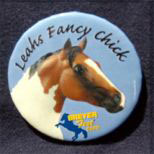But Stone horses came rather late to the customized hair party. The first plastic horse company to offer molds with two different hairstyles was Hartland, whose Large Champ horses sported two hairstyles and Small Champ horses had a choice of two tails -- all available before 1956. Later, the Chubby followed suit with two mane styles, the Standing/Walking horse came with either a roached mane or a wavy mane and three distinct tail types, while the Semi-Rearing Mustangs came with manes that stood up or laid down and with plain or fancy tails. All these styles were available to collectors by 1960. In general, the wavy, upright manes are considered to be more attractive than the flat or shaved ones, as they tend to add life and expression to the sculptures.
Roached and wavy manes on Hartland's Standing/Walking horse
Breyer's first experiments in customization came with the unicorn customizations on the Running Stallion and Lying Foal (in 1982 and1985, respectively). But discounting flockies, which not only had different hair but customized fuzzy bodies, the first Breyer horse to come in two different hairstyles was Halla (braided mane) when the loose-maned Boyla was released in 1992. It's possible, though, that the braided Halla mold is no more, as only a couple of very limited release Hallas have turned up since Boyla's debut, and those may have been crafted out of old body stock. Similarly, when Sherman Morgan got a new 'do in 2000, with the exception of one Breyerfest auction model in 2001, the old Shermie disappeared.
However, if we don't count these, or such minor retoolings as the reduction of the number of Gem Twist's braids or the tail being taken away from the butt of the Saddlebred Weanling, then Breyer's first horse with two 'dos available at the same time would be the Show Jumping Warmblood in 2004.
Now of course, it's becoming commonplace to find Breyer offering a variety of hairstyles on models such as Lady Phase (2005/2006), Strapless (2005/2008), the Cleveland Bay (2007/2012), the Stock Horse Stallion (2008), Newsworthy (2008), the POA (2009), the Justadream Arabian (2009), Roxy (2009/2010), Smarty Jones (2012), Laredo/Brishen (2012/2013/2014), Idocus (2013/2016), Ruffian (2015), the Marwari (2015), and Shannondell (2016).
After Breyer, the next plastic horse company to experiment with interchangeable hairstyles was Creata Winner's Choice with their Gold Standard horses in 1997/1998. Designed by Candace Liddy, the same sculptor who designed Creata Winner's Choice Micro Minis, the Gold Standard were Traditional scale models that came with extra manes and tails that could be combined as the owner/shower saw fit. Some flaws in the plastics used for these sets made them tough to work with, but the problems related more to the fitting of tack than to the switching of the hair pieces.
ISH tails
Stone didn't actually show up at the customization party until the Ideal Stock Horse, Performance Horse, and Pony molds were released in 1999/2000. The Ideal Stock Horse (or ISH) was available in at least four mane and tail combinations (long mane, long tail; long mane, short tail; short mane, short tail; and short mane, long tail), the Pony in three combinations (English mane/tail, Western mane/tail and Combo English mane with Western tail), and the Performance Horse in two (short manes and roached manes). Before long we had windswept manes, manes that flowed two ways, and manes that stood bolt upright. The same mold could be modelled as a stallion, gelding, or mare. Ears began to twitch and switch, heads changed positions, feet were shuffled, paint and finishing choices were offered -- the tweaking went on and on and on until we came to where we are today, when virtually no two Stones look exactly alike.
Horses with fancy hairdos have come a long way, baby, from their roots. Who would have thought that all this could come from a simple pair of ponies having good hair and bad hair days?






















